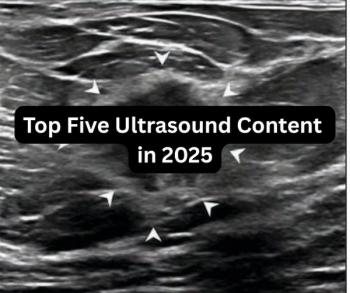
Report from ECR: Size and trajectory matter most in lung RF ablation
“I predict that lung radiofrequency ablation is going to be very big indeed,” said Dr. Alice Gillams at the beginning of her two presentations at the European Congress of Radiology in Vienna Saturday examining factors influencing tumor recurrence and incidence of pneumothoraces.
"I predict that lung radiofrequency ablation is going to be very big indeed," said Dr. Alice Gillams at the beginning of her two presentations at the European Congress of Radiology in Vienna Saturday examining factors influencing tumor recurrence and incidence of pneumothoraces.
Gillams and colleague Dr. William Lees from University Hospital London found that tumor size and location have the biggest impact on recurrence, while the number of tumors and the anticipated electrode trajectory influence the rate of pneumothorax.
The researchers retrospectively reviewed records of 52 tumor ablations in 28 patients with lung metastases up to 6 cm in size. The ablations were considered complete as assessed by contrast-enhanced CT and more than two months of follow-up. Eleven tumors were treated with expandable and 38 with water-cooled electrodes.
Recurrence occurred in 26 tumors, anywhere from four to 18 months postprocedure. The researchers found that recurrence was more common in larger tumors (mean 2.6 cm) and those centrally located and in tumors smaller than 3.5 cm treated with expandable electrodes. Size was the only factor that reached significance, although electrode type came close at p = 0.06. A peripheral location - within 5 mm of the pleura, for example - was significantly associated with lower rates of recurrence.
Gillams said that tumors often appear to be treated well, but on follow-up, nodules are seen to develop adjacent to the ablation zone. To help avoid this, researchers have changed their protocol. Now, they retract the electrode, turn the tines 90°, and go back.
"We'll have to wait for more data to determine if this new protocol will have an impact on recurrence rates," she said.
Gillams called the recurrence rate of 7% extremely competitive with traditional therapy.
Factors associated with pneumothorax following percutaneous lung biopsy are well described. But, in a study analyzing factors that influence incidence of pneumothorax, Gillams noted that RFA differs in that larger electrodes, multiple electrode positions, long dwell times, and often targeting multiple tumors are necessary.
To determine which of these factors weighs heaviest in causing pneumothoraces, researchers reviewed records of 37 patients with 79 tumors (mostly metastases) in 55 lungs.
Significant factors influencing the 21 pneumothoraces in the study were the length of electrode trajectory through aerated lung, number of tumors ablated, and number of electrode positions. While the number of patients with emphysema was small, 67% of these patients developed pneumothorax.
Gillams suggested her data can be used to better triage patients.
"Pneumothorax is a common side effect of doing this procedure, but it doesn't have to be a scary complication," Gillams said. "Most interventional radiologists have an aspiration needle or drainage catheter on the ready. But if you're treating a patient with many tumors or one with a lot of aerated lung to cross, you can anticipate a high risk of pneumothorax."
For more online information, visit Diagnostic Imaging's
Newsletter
Stay at the forefront of radiology with the Diagnostic Imaging newsletter, delivering the latest news, clinical insights, and imaging advancements for today’s radiologists.




























